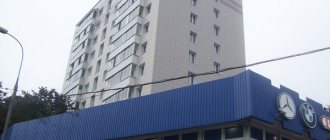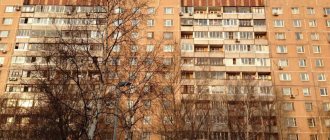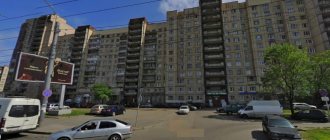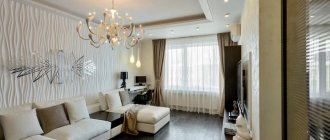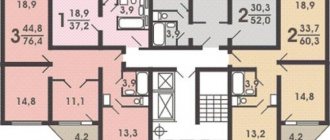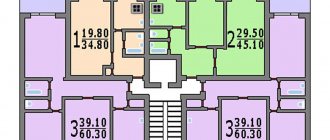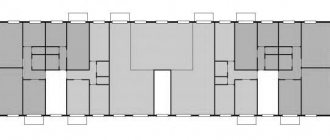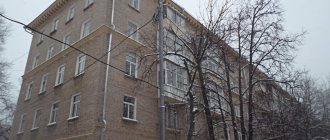| It is proposed to rename this page to “ II-66 ». Explanation of reasons and discussion - on the Wikipedia page: Towards renaming/July 30, 2020 . |
Houses of series II-66 in the Biryulyovo Vostochny district of Moscow
II-66
- a standard series of residential 9-12-story buildings, the construction of which was carried out from 1973 to 1983 in Moscow, Odintsovo and Zheleznodorozhny[1].
The series was designed by MNIITEP[1]. During the construction of the houses in the series since 1973, long construction times and expensive construction technology became obvious, and therefore it stopped being built in 1983. The houses in the series have one passenger elevator with a lifting capacity of 450 kilograms, a garbage chute with a loading valve on each floor and separate bathrooms. The outer walls, the thickness of which is 51 cm, are made of brick, the ceilings are made of round-hollow panels 22 cm thick. The load-bearing walls in the buildings are an internal reinforced concrete frame and horizontal ceilings made of reinforced concrete slabs, complicating the possibility of redevelopment of the apartments. A special feature of the series was the absence of one-room apartments[2].
Series II-18
One of the first multi-storey standard residential buildings in Moscow.
Mostly these are block single-entrance “towers”, but sometimes a brick version of the series is also found (II-18-01/08MIK). The very first houses in this series were eight floors (II-18-01/08), then another floor was added (II-18-01/09) and subsequently they grew to 12 floors (II-18-01/12).
Despite the fact that these houses are mostly single-section, interlocking two-entry versions of twelve-story buildings were also built (II-18-02/12).
Despite the increased number of floors, II-18/12 is a typical Khrushchev building. Load-bearing walls are transverse walls - some interior walls and staircase walls. Thanks to the wide spacing of load-bearing walls, almost all rooms in the apartments are separated by partitions. Although in the dimensions of two-room apartments there is usually a load-bearing wall between the rooms with an opening in the middle.
Quite often, owners want to seal up this opening and make an entrance to the back room from the corridor.
In the 8th and 9th floors of II-18 there are only one-room and two-room apartments, and in II-18/12 there are three-room apartments, as well as a second elevator. In twelve-story buildings, the kitchen area was also increased (but not in all apartments).
The external walls in the houses of series II-18 are expanded clay concrete blocks, 40 cm thick. The thickness of the internal expanded clay concrete blocks is 39 cm. The partitions are gypsum concrete, 8 cm thick, the ceilings are hollow-core panels, 22 cm thick.
It is interesting that one of the walls, the one that separates the toilet or bath from the staircase, is made almost of plastered plywood and is easily broken through by hand.
- The kitchens are gasified, which imposes some restrictions on remodeling.
- Currently, these houses are being actively renovated; series II-18 is not yet included in the plans for demolition.
- The I-209A block houses became an improved version of this standard series.
Where to place the refrigerator in the Brezhnevka kitchen
No kitchen can do without a refrigerator, which is one of the main household appliances in it. If the room is very small, you can refuse a food processor, microwave oven, or multicooker, but a refrigerator in which perishable foods are stored must be on it.
Since this unit is very bulky and takes up quite a lot of space, you should think carefully about where it is best installed so that it does not disturb the harmony of the interior. There may be several options.
It is important to remember that manufacturers do not recommend installing the refrigerator next to the stove.
Corner - designers advise placing all massive objects against the wall, if possible, in a corner. This is the ideal place for a refrigerator. To save precious square meters, you should choose the tallest and narrowest refrigerator model.
Directly above it you can place several shelves for storing various kitchen utensils. Thus, the angle will be used as rationally as possible.
If the kitchen set is made to order, then you can easily design an additional cabinet above the refrigerator.
At the door - this place is also quite popular. Both options are great for installing a refrigerator. To ensure that there are no gaps between it and the set, it is recommended to order furniture for the Brezhnev kitchen, made according to individual parameters. Then all the items will fit perfectly into the interior, and even the smallest room will become convenient and comfortable.
This headset layout allows you to make maximum use of the available storage space.
Under the work surface - if the family is small and you don’t need a lot of food, then it is best to buy a small refrigerator that can easily fit under the bar counter, dining table or work table. As a rule, the height of such a unit is approximately 50 cm. Most likely, it will not have a freezer, or it will be too small.
The freezer can be placed separately in another room of the apartment.
Outside the kitchen - if there is no space for a refrigerator in the room itself, this problem should be solved radically. The unit can be installed in the corridor or on the balcony (if it is covered). The hallway and pantry are also suitable - the main thing is to choose a place where the refrigerator will definitely not disturb anyone.
On the balcony it is better to place the refrigerator in a place where there is less sunlight.
List of series houses in the Moscow region
Yeniseiskaya - 17, building 3, Seligerskaya - 14, Dmitrovskoye - 105, building 4, Marshala Tukhachevsky - 28, building 1, Marshala Zhukov - 22/1, Altaiskaya - 7, Novatorov - 32, building 2, Novatorov - 32, building 1, Sevastopolsky – 28, building 1, Nizhnelikhoborsky 3rd – 13, building 2, Nizhnelikhoborsky 3rd – 13, building 1, Academician Scriabin – 32/175, Lomonosovsky – 41, Michurinsky – 8 , building 1, Michurinsky – 8, building 2, Onega – 29, Akademicheskaya B. – 14, Likhoborskie Bugry – 11, Cosmonauts – 10, building 2, Rustaveli – 10, building 4, Taininskaya – 24, Demyan Bednogo – 2, building 1, Marshal Zhukov – 10, Marshal Zhukov – 55, Marshal Zhukov – 57, Marshal Tukhachevsky – 22, building 1, Marshal Tukhachevsky – 24, building 1, Marshal Tukhachevsky – 26, building 1, Marshal Tukhachevsky – 38, building 1, Marshal Tukhachevsky – 40, building 1, Marshal Tukhachevsky – 42, building 1, Marshal Tukhachevsky – 44, building 1, Touristskaya – 2, building 1, Touristskaya – 2, building 2 , Tourist - 2, building 3, Tourist - 2, building 4, Tourist - 4, building 1, Tourist - 4, building 2, Tourist - 4, building 3, Tourist - 4, building 4, Tourist – 6, building 1, Touristskaya – 6, building 2, Touristskaya – 6, building 3, Touristskaya – 6, building 4, Baumanskaya – 19, Rusakovskaya – 9, Gilyarovsky – 12, Nizhegorodskaya – 11, Donskaya – 23 , Kapotnya 3rd – 5,
Note: This list contains up to 50 random houses of the specified series
Main characteristics of the layout
Based on the method of construction, houses in this series (2-18-01/12) are classified as block houses, and the project provides only “towers,” that is, buildings with one entrance. In houses of series II-18/12, some two-room apartments have adjacent rooms, and some have separate rooms.
- Series: II-18-01/12
- House type: block
- Manufacturer: Concrete Concrete Plant No. 2 (now – Reinforced Concrete Structures Plant No. 2, part of MPSM - the production division of Glavstroy Corporation)
- Years of construction: 1962 – 1972
- Number of floors: 12
- Number of rooms in apartments: 1, 2, 3
- Height of living quarters: 2.64 m
- Number of apartments per floor: 7 (less often -

- Number of sections (entrances): 1 (less often – 2)
- Elevators: 2 passenger
- Stairs: without common fire balcony
- Ventilation: natural exhaust through ventilation units in the kitchen
- Garbage disposal: garbage chute with loading valve on the interfloor landing
- Technical premises: technical underground and technical floor for the placement of utilities
- Balconies: balconies in all apartments starting from the 3rd floor
- Baths: standard (not sitting)
- Bathrooms: in 1-room apartments - combined, in 2- and 3-room apartments - separate
- External walls: expanded clay concrete blocks 400 mm thick
- Internal walls: expanded clay concrete blocks 390 mm thick
- Partitions: gypsum concrete 80 mm
- Floors: hollow-core panels 220 mm thick
Currently, houses of this series are included in the priority capital repair plan: communications and window units are being replaced, glazing of balconies, insulation and cladding of external walls.
This program is being successfully implemented in Zelenograd.
Furniture placement and fittings
Kitchen renovation in Brezhnevka begins with the development of a design project that will allow you to see the interior of the future room. To do this, you can use a computer program or arm yourself with a pen and a piece of paper. If the apartment is not planned for major repairs and redevelopment, then the furniture placement options may be as follows.
- Corner kitchens for Brezhnevka are the best way to rationally use space. The set is located along two perpendicular walls with corner coverage. This layout allows you to comply with the so-called triangle principle, i.e. visual combination of the refrigerator, stove and sink. With such placement in the kitchen, it is very convenient to cook, since there is no need to waste time and energy on unnecessary maneuvers.
- With a linear layout, furniture and household appliances are placed in one row along a blank wall. The main emphasis is on the dining area, where you can place a corner, dining table and chairs. This option is more suitable for people who spend little time at the stove.
We recommend: Design of a studio apartment with an area of 28 sq. m with photo
Description
According to construction technology, residential buildings of series II-18 are classified as block buildings. They were conceived in the form of original “towers” (as they are called everywhere), i.e. single-entrance high-rise buildings, but two-section buildings of this type were also erected; also in the capital one three-entrance house was built according to this project.
The first eight-story Khrushchev buildings were erected in 1958 in the Cheryomushki quarter, which was considered experimental.
Subsequently, series II-18 houses were erected en masse in the 60s and early 70s of the last century, during the period of active development of such metropolitan areas as Degunino, Khovrino, Golyanovo, Perovo, Koptevo, Medvedkovo, Kuntsevo, Tishinka, etc. The 12-story version of the series was built in the Tver region, the city of Vidnoye, the Republic of Tatarstan, and the Vladimir region. In total, more than 1,200 houses were built according to the standard II-18 project.
The capital authorities raised the issue of demolishing houses II-18, but in the end it was decided to rehabilitate such buildings and they were included in the first place of the refurbishment (overhaul) plan.
From the mid-2000s to the present, in more than 250 houses in the series, window units have been replaced with new ones, communications have been modernized, loggias have been glazed, and in some houses, external wall insulation has been done and they have been lined with modern façade panels.
Typical apartment layouts: Brezhnevka, Stalin and Khrushchev
Typical apartment layouts are typical for a whole series of houses - a group of residential buildings that are completely or almost completely identical in design and arrangement of rooms. Also, such houses are built from the same materials.
Typical apartment layouts include “Brezhnevka”, “Khrushchevka”, “Stalinka”. Houses from these series are found in almost every locality in the country.
Typical layout of Stalinka apartments
Stalinist houses are still expensive and prestigious. This is mainly due to their location: as a rule, “Stalin” buildings are located in the city center and in the areas closest to it. In addition, the cost of housing is also affected by the large total area, as well as high ceilings.
“Stalin buildings” are divided into two types depending on the building material used: cinder block and brick. Most brick houses were built during the early period, and cinder block houses began to appear at a time when developers had access to building panels and blocks. Brick buildings usually have better thermal insulation and a more attractive façade. Cinder block houses look less elegant and sometimes downright dull.
The construction of “Stalinka” buildings decreased significantly in 1956, when industrial mass housing construction began, which became the reason for the appearance of entire arrays of “Khrushchevka” buildings.
The main features of the “Stalinka” layout:
- High ceilings;
- Convenient layout of “Stalinka”;
- Massive walls.
In “Stalin” apartments there are usually three- and four-room apartments; options with two, as well as five or more rooms are much less common. One-room apartments are completely rare.
“Stalin buildings” can refer to ordinary or nomenklatura houses. Nomenklatura apartments were built specifically for elite residents. These houses have an excellent layout and spacious hallways. The apartments may also contain not only a children's room, but also an office, a library, and a maid's quarters. The kitchen in these “Stalin” apartments is large, the bathroom is separate. Usually there are 2-4 apartments on one floor. Row houses are simpler and more modest; the area of apartments in them is smaller.
Typical layout of Khrushchev apartments
“Khrushchevka” refers to five-story buildings, the construction of which began in the period 1956-1964, during the reign of Khrushchev. In Moscow, these buildings were built until 1972, and in the region itself and in many other regions of the country - until the mid-1980s.
At first, Khrushchev houses were built of brick, but in the 60s, for economic reasons, panel housing construction began. Apartments in “Khrushchev” buildings have a small area of rooms (for example, 6-9 m2 were allocated for a bedroom), and the area of kitchens does not exceed 6 m2. The ceiling height has also decreased - to 2.5 meters.
The main disadvantages of the layout of Khrushchev apartments include:
- Poor thermal insulation (hot in summer and cold in winter);
- Combined bathroom;
- Lack of garbage chute, elevator, attic.
But these houses also have their advantages. This is, first of all, the low cost of apartments and a good territorial location - close to the metro, in areas with developed infrastructure.
Typical layout of Brezhnevka apartments
Typical "Brezhnevka" houses were built during Brezhnev's time - from 1964 to the beginning of the 80s.
Unlike the Khrushchev buildings, such houses had a larger number of floors and an increased area of apartments. In the very first apartments there was often a “Khrushchev refrigerator”, which was a closet under the kitchen window. This solution was borrowed from the Khrushchev era. The bathroom was created separately. Subsequently, the layout changed slightly; some of the solutions are still used today.
Brezhnevkas are characterized by an improved layout. But this is true only in relation to “Khrushchev” buildings; as for “Stalin” buildings, they are more comfortable for living. In Brezhnevka houses, the ceilings are not too high, the kitchens are small (about 7-9 m2). The number of rooms varies from 1 to 5.
One of the varieties of “brezhnevka” apartments are hotel-type apartments. They are small, their total area is 12-18 square meters. Such apartments were intended for temporary stay, but then most of them were assigned on a permanent basis.
The Brezhnev houses have an elevator, a garbage chute, and the ceiling height is 2.65 meters.
Most buildings are poorly insulated and have recently undergone major renovations to improve energy efficiency.
Modern apartment layout
Since the mid-90s of the last century, they have been trying to give individuality to typical buildings. As a result, they cannot be classified as a specific type of layout. During Yeltsin’s period of power, “elites” emerged, but their series do not have similar features. Their construction began in connection with changes in housing standards, due to which the apartments began to have a larger area and an improved layout.
We recommend: Design of small studios: original design solutions
Design features of the series and facade finishing
The block external walls of the houses in this series are made of expanded clay concrete 40 cm thick, and the ceilings are hollow-core panels 22 cm thick. But there is also a “brick” version of the standard project - II-18/12 MIK.
Initially, II-18 had eight floors, then the designers added a ninth, and later increased the height of the buildings to 12 floors. Accordingly, the 12-story building received an additional elevator, apartments with three rooms, and the kitchen area was increased.
Due to the number of floors of building II-18, many have difficulty determining the period of its construction.
However, this is still the same typical “Khrushchev” with transverse load-bearing walls, which include all inter-apartment walls and walls of staircase landings.
The elevator shaft doors and garbage chute loading valves in buildings II-18 are located on the interfloor platforms. During construction, the facades of II-18 were not painted, but during the process of renovating the houses of this series, the outer walls were painted blue, yellow, pink and other colors.
Choice of colors and furniture
Visual expansion of a small kitchen with a mirror
Due to the fact that Brezhnevka kitchens have a small area, the main task is to visually expand the space.
This can be achieved using several techniques:
- correctly selected colors – these are mainly light colors;
- mirrors and glossy surfaces, these nuances are used both in choosing a kitchen for Brezhnev and in the selection of finishing surfaces;
- Proper lighting in combination with the above points will help achieve the desired visual effect.
Serious attention should be paid to how you arrange kitchen furniture, sinks and household appliances. It may be necessary to relocate communications. There is no need to be afraid of this.
Most of the preparatory work can be done by yourself. The main thing to remember is that all your expenses will pay off, because as a result, the kitchen will become the soul of the apartment and a favorite place for all family members.
Photo of a corner kitchen with a sink by the window
The kitchen for Brezhnevka should be small, since space is limited. Non-standard forms can be used.
If the layout allows, the best option is a corner kitchen.
It is very functional, practical and ergonomic and allows you to make the most of the space.
To make better use of space, the space under the oven can be converted into a pull-out drawer where baking utensils will be stored.
Household appliances can easily be placed in the lower part of the kitchen. It can be hidden behind a beautiful furniture facade or left open.
The sink can be installed to the left or right of the corner, and an electric kettle, coffee maker or toaster can be placed in the free space.
Elegant style of modern small kitchen
Neat closed cabinets in the corner will give your small kitchen a complete look. If you provide a built-in hood, it is quite possible to make an additional cabinet above it.
This will allow you to make the most of your free space. And additional storage space won't hurt anyone.
Note! As an apron in a Brezhnevka kitchen, you can use not only tiles, but also a wall panel. It is easy to install and perfectly hides wall imperfections.
It is better to choose the color of the panel to match the countertop. This will visually increase the work space.
The color of the kitchen furniture should be in contrast to the color scheme of the finishing. For example, a light apron can be interspersed with a contrasting dark color to match the furniture.
Then the overall background of the kitchen will be light, and interior elements such as furniture and accessories will be in a different contrasting color.
The video posted on this page will show interesting design options for small kitchens in Brezhnevka.
Features of apartment layouts
In the layout of 2-room apartments in a series, homeowners usually do not like the opening in the load-bearing wall between adjacent rooms. Most residents seal it up and form a new entrance to the room from the corridor, making the rooms isolated.
The standard disadvantages of this series include the adjacency of rooms in some apartments, as well as the small area of kitchens and hallways.
In one-room apartments there are “sitz” baths. A more serious problem was a design defect: due to the fact that the design provided for separate foundations for the main facade and the remaining walls, in some cases the shrinkage of different parts of the high-rise building was uneven.
Where to install a gas water heater in a Brezhnevka kitchen
If the kitchen is small, then there is a catastrophic lack of storage space. A geyser is a necessary device that cannot be abandoned. However, there are several different ways to safely hide it and make your kitchen more spacious.
In addition to being bulky, the speaker also does not have a very aesthetic appearance, so it would be appropriate to hide it behind the facades of the headset.
Moving to the corridor - this measure can only be used if the kitchen is really very small, and the free space in it is necessary to place other important items.
It is important to understand that moving the speaker outside the kitchen is only possible if certain conditions are met:
- the corridor must be spacious, the distance between its two opposite walls must be at least one meter;
- the total volume of the room into which the gas water heater is installed must be at least 7.5 square meters. meters, and the ceiling height is at least 2.35 meters;
- the geyser can only be installed on a solid wall;
- the room must be equipped with a ventilation duct.
You can choose the size of the cabinets to match the size of the column, and then everything together will look quite harmonious.
We recommend: Apartment design in light colors with photos
Moving a gas water heater within the kitchen is a controversial decision, but this task can be accomplished. You can install the unit in a corner where it will be least noticeable and will not interfere.
However, it should be understood that moving a speaker over a long distance, even within the kitchen, is already a replacement of a household device, requiring the installation of new gas communications. We will have to legitimize this process, spending a lot of time on it.
It is also better to cover the corner in which the column is located with a façade.
Building a water heater into a cabinet is the best way to disguise a gas water heater. However, it is not always legal, since in some cities it is prohibited to hide a gas water heater behind extraneous structures.
Before starting this process, you should consult with specialists. If such a unit has an open gas chamber, then it is better to disguise it with a false cabinet that has no top and bottom. If the gas chamber is closed, then the cabinet may be real. The geyser should be installed at the same level as the hanging cabinets.
Specifications
- Alternative name: II-18
- Construction regions:
In the capital, the districts of Koptevo, Basmanny, Beskudnikovo, Zelenograd, Degunino, Khovrino, Solntsevo, Obruchevsky, Zelenograd, Khoroshevo, Northern Tushino, Bogorodskoye, Metrogorodok, Shchukino, Kuntsevo, Aminyevo Zyuzino, Nagorny, Tsaritsyno, Nagatino, Izmailovo, Golyanovo, Tekstilshchiki, Kuzminki, Perovo, Medvedkovo, Tishinka, etc.
Also, high-rise buildings under this project were built in the Vladimir and Tver regions, Tatarstan (Kazan, Naberezhnye Chelny).
- Construction technology: block
- By construction period: Khrushchev
- Years of construction: Moscow: 1958-1972, other regions: 1964-1975
- Prospect for demolition: Demolition is not envisaged
- Number of sections/entrances: 1 (sometimes 2)
- Number of floors: 8, 9 or 12
- Ceiling height: 2.50 m
- Balconies/loggias: Balconies in each apartment from the 3rd to the 12th floor
- Bathrooms: in one-room apartments – combined (“sitz” baths), in two- and three-room apartments – separate, standard baths
- Stairs: without common fire balcony
- Garbage chute: with loading valve on the interfloor platform
- Elevators: One or two passenger (load capacity - 400 kg)
- Number of apartments per floor: 7 (in separate buildings –

- Apartment areas:
Shared/living/kitchen 1-room apartment 35/20/9.7 2-room apartment 37-48/24-35/6-9.5 3-room apartment 64/47/9
- Ventilation: natural exhaust, ventilation units are located in the kitchen and bathroom
- Walls and cladding:
The material of the external walls is slag concrete (blocks 40 cm thick). Inter-apartment walls are made of gypsum slag concrete (20 cm), partitions are made of gypsum slag concrete panels (8 cm). The houses were built without facade cladding.
- Roof type: flat, covering – roll
- Manufacturer: Concrete Concrete Plant No. 2 (currently part of MPSM - a production division of the Glavstroy Development Corporation)
- Designers: SAKB APU Moscow (now MNIITEP).
- Advantages: The layout allows you to isolate adjacent rooms if desired. The kitchens are large in size, the bathrooms are separate (in most apartments).
- Disadvantages: Small hallways.
Due to the fact that the design provides for separate foundations at the main facade and the remaining walls, in some cases uneven shrinkage of various parts of the high-rise building occurs.
Design features of the series and facade finishing
The main difference of this series is that its houses were conceived and designed in the form of single-entry towers. Over time, two- and even three-section buildings were erected. However, this phenomenon did not become widespread. To this day, in Moscow, Kazan, Naberezhnye Chelny, and many cities of the Tver and Vladimir regions, the silhouettes of residential buildings II 18 - 01 MN are recognizable.
Because of their shape and the white (sometimes light beige) paint used to paint the outer walls, the towers are also called “milk cartons” and “pencil cases.”
Other features of the series:
- External walls made of 40-centimeter expanded clay concrete blocks;
- Reinforced concrete floor made of hollow-core panels 0.22 m thick;
- Partitions are made of 80 mm thick gypsum concrete;
- 2 passenger elevators at the entrance;
- Garbage chute;
- Loading valve between floors;
- Flat roof, etc.
Short description
The less common standard series of panel houses P-22 has only three modifications: P-22K, P-22/16 and P-22/25. Modification P22K is an improved version of previous modifications, which is one step wider and has one more staircase added.
Panel houses of the P-22K standard series were built almost point by point and for a very short time: in the period from 1982 to 1987.
We can say that the P-22K standard series practically turned out to be experimental, since it was not widely used, because at that time another more cost-effective standard panel series P-3 took the lead in mass construction, which we can still see in many areas of Moscow built in the eighties.
- The exact addresses of houses of the P-22K series in Moscow: Rublevskoye Shosse, 44k1, 44k2; Autumn Boulevard, 2; st. Koshtoyantsa, 6, 10; Barvikhinskaya st., 4k1, 4k2
Location in Moscow and Moscow region
In Moscow, houses of the P-22K series were built in the following areas: Troparevo, Prospekt Vernadskogo metro station, Krylatskoye, Mozhaisky.
No houses of the P-22K series were built in the Moscow region
Houses in this series
- Moscow, Akademika Koroleva str. 3, building 1, 5
- Moscow, Academician Skryabina st. 32/175
- Moscow, Akademicheskaya Bolshaya st. 14
- St. Petersburg, Altayskaya street 7
- Moscow, Artekovskaya st. 4 building 1, 4 building 2, 6, 8
- Moscow, Architect Vlasov str. 19, building 3
- Moscow, Balaklavsky Prospekt 24 building 2, 24 building 3, 4 building 1, 4 building 4, 4 building 6
- Moscow, Baumanskaya street 19, 19 building 1
- Moscow, Bashilovskaya street 6-8 building 2
- Moscow, Bolotnikovskaya st. 7 building A, 7A, 9, 9 building 1
- Moscow, Varshavskoe sh. 194 building 16, 53 building 1, 57
- Moscow, Vinokurova str. 28, building 2
- Moscow, Volgogradsky pr-kt 158/31, 158/31 building 1, 173, 173 building 1, 175/32, 175/32 building 1
- St. Petersburg, Vsevolod Vishnevsky st. 8
- Moscow, Generala Glagolev st. 14
- Moscow, Geroev-Panfilovtsev st. 51
- Moscow, Gilyarovskogo str. 12, 12 building 1
- Moscow, Demyan Bednogo st. 1, 2, 2 building 1
- Moscow, Donskaya street 23
- Moscow, Donskoy 3rd proezd 9/6
- Moscow, Yeniseiskaya st. 17, building 3
- Moscow, Zelenodolskaya street 28 building 1
- Moscow, Kosmonavta Volkova st. 11
- Moscow, Kosmonavtov alley 10 building 2
- Moscow, Krasnobogatyrskaya st. 141/1 building 1, 141/1 building 2
- Moscow, Krasnokholmskaya embankment 5-9, 5/9
- Moscow, Likhoborskie Bugry st. 11
- Moscow, Likhoborsky Nizhny 3rd Ave. 13 building 1, 13 building 2
- Moscow, Lomonosovsky pr-kt 3 building 2, 3 building 3, 3 building 4, 41
- Moscow, Marshala Zhukova Ave. 10, 10 building 1, 22/1, 55, 57, 57 building 1
- Moscow, Marshala Tukhachevsky st. 22 building 1, 24 building 1, 26 building 1, 28 building 1, 32, 32 building 1, 34, 34 building 1, 38 building 1, 40 building 1, 42 building 1, 44 building 1
- Moscow, Michurinsky pr-kt 8 building 1, 8 building 2
- Moscow, Nagorny proezd 5 building 1
- Moscow, Narodnogo Opolcheniya st. 2, 2 building 2, 2/32
- Moscow, Nizhegorodskaya street 11 building B, 11 building V
- Moscow, Novatorov str. 32, 32 building 1, 32 building 2
- Moscow, Novokuzminskaya 4th street 13, 13 building 1
- Moscow, Outskirts 1st st. 5
- Moscow, Onezhskaya st. 29
- Moscow, Roshchinskaya 3rd street 5
- Moscow, Rusakovskaya embankment 9
- Moscow, Rustaveli st. 10, building 4
- Moscow, Sevastopolsky pr-kt 28 building 1, 75 building 1, 75 building 2
- Moscow, Seligerskaya street 14
- Moscow, Taininskaya street 24, 24 building 1
- Moscow, Turistskaya st. 2 building 1, 2 building 2, 2 building 3, 2 building 4, 4 building 1, 4 building 2, 4 building 3, 4 building 4, 6 building 1, 6 building 2, 6 building 3, 6 building 4
- Moscow, Festivalnaya st. 53 building 1, 53 building 4
- Moscow, Tsyurupy st. 16, building 2, 4
- Moscow, Cast Iron Gate st. 9A
- Moscow, Yaltinskaya street 7 building 1
- Moscow, Yana Rainisa Blvd. 24, building 1
Brezhnev houses ("Brezhnevki")
The five-story Khrushchev buildings were replaced by Brezhnevkas. The initially eight- to nine-story buildings in the series grew to 12 and 16 floors by the mid-70s. Elevators and garbage chutes appeared in Brezhnev's houses. Thermal and noise insulation has been significantly improved. The layout in Brezhnevkas has become much more convenient. Brezhnevki, the construction of which began in the 1970s, are in many ways prototypes of modern standard new buildings. If you are interested in premises in Moscow for the activities of your work team, company, legal organization and other forms of work, then we recommend paying attention to the profitable office rental near the Alma-Atinskaya metro station.
Moscow
| Series | Wall material | Number of storeys | Years of construction |
| II-29 | brick | 8-10 | 1965-1970s |
| II-66 | brick | 9-12 | 1973-1983 |
| Vulykha tower | brick | 12,14,15,18 | 1967-2003 |
| Tishinskaya Tower | brick | 12 | 1977-1984 |
| Smirnovskaya Tower | brick | 12-13 | 1969-1981 |
| Moskvorets. tower | brick | 12,14 | 1980-1991 |
| 1-515/9m | panels | 9 | 1966-1980 |
| 1-515/9sh | panels | 5,9 | 1966-1984 |
| I-700 | panels | 22 | 1977-1994 |
| 1605/9 | panels | 9 | 1965-1972 |
| 1605/12 | panels | 12 | 1969-1985 |
| II-49 | panels | 9 | 1965-1985 |
| II-57 | panels | 9-12 | 1963-1970 |
| P-3 | panels | 4-17 | 1970-1998 |
| P-44 | panels | 5-17 | 1978-2001 |
| P-30 | panels | 5-14 | 1971-2005 |
| P-4 | panels | 22 | 1972-1987 |
| P-42 | panels | 16 | 1972-1979 |
| P-43 | panels | 16 | 1972-1985 |
| P-46 | panels | 12-14 | 1971-1998 |
| P-55 | panels | 9-14 | 1978-2002 |
| I-521a | panels | 25 | 1974-1994 |
| I-760a | panels | 9 | 1960-1983 |
| PP-70 and PP-83 | panels | 10,14 | 1980s-1990s |
| "Swan" | panels | 16,20 | 1966-2003 |
| II-68 | blocks | 16 | 1969-1989 |
| II-68-02 | blocks | 12 | 1968-1984 |
| II-68-03 | blocks | 12 | 1968-1981 |
| II-68-04 | blocks | 12 | 1970-1975 |
| I-209a | blocks | 14 | 1970-1980 |
| I-491a | blocks | 7,9,11,16 | 1974-1983 |
| I-522a | blocks | 9,14,16 | 1977-1993 |
| II-18/9 | blocks | 8,9 | 1958-1968 |
| II-18/12 | blocks | 12 | 1966-1973 |
| 1-mg-600 | panels | 9 | 1965-1975 |
| 1-mg-601 | panels | 16-19 | 1965-1975 |
| I-III-3 | panels | 9-16 | 1979-1993 |
Saint Petersburg
| Series | Wall material | Number of storeys | Years of construction |
| 1-528KP-40 | brick | 9 | 1963-1980s |
| 1-528KP-41 | brick | 9 | 1963-1970s |
| 1-528KP-80 | brick | 14 | 1968-1985 |
| 1-528KP-82 | brick | 16 | 1970s-1980s |
| Shch9378 | brick | 15 | 1970s-1980s |
| Ш5733 | brick | 12,14 | 1960s-1970s |
| 600 (1-LG-600) | panels | 5,9,12,15 | 1969-1982 |
| 602 (1-LG-602) | panels | 9 | 1966-1981 |
| 121 | panels | 3 | 1970s-1980s |
| 1-LG-600-I | panels | 12,15 | 1970s-1982 |
| 606 (1-LG-606) | panels | 9 | 1966-1973 |
| 131 | panels | 9 | 1970s |
| 137 | panels | 9-17 | 1974-1992 |
